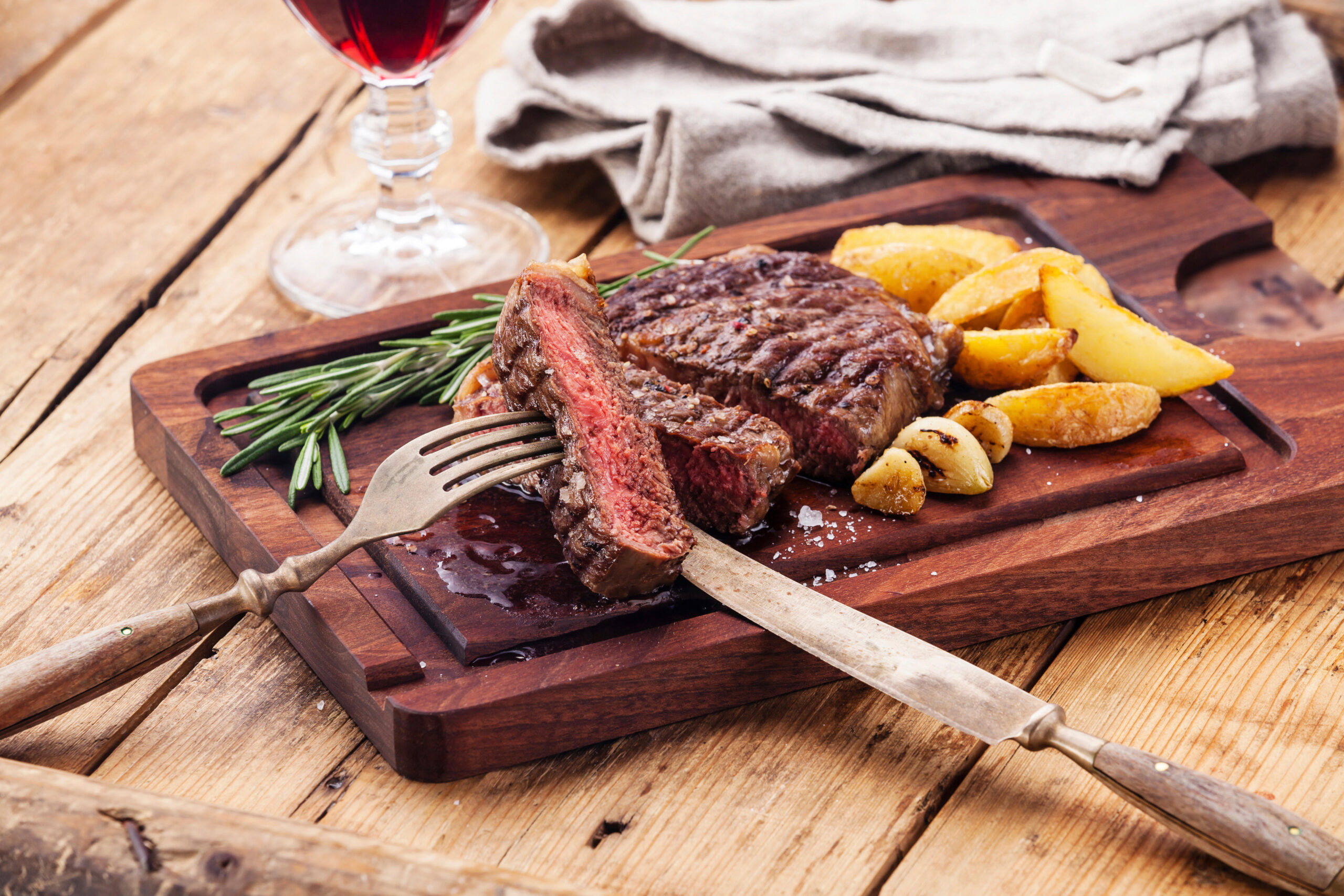The five best beef cuts for the perfect steak
Because nothing says 'I love you' like a huge slab of meat.

Although many a cook would argue that the pig is a trottered suitcase of infinitely more options than the cow, I stand by team cow. Sadly, I cannot dwell on the delights of pressed-muzzle vinaigrette or poached tongue, beetroots and horseradish, as I must concentrate on the love of steak alone.
Nonetheless, a steak is, and should absolutely always be, a treat, however often eaten. When it comes to bread, I cannot deny chewing on sliced white pigeon food and I must admit to having drunk a lot of cheap, bad wine, but with steak, I will pay the price down to that last spinning gold coin.
It’s the price that must be paid for what should always be a great life with one bad day—the way I hope to go. I don’t care to know the Christian name of a particular cow or even which field it’s from, as I believe this storytelling is often a hoodwink for quality. Beef cattle should be husbanded with love and grown slowly on good pastures.
They will get fat in the right places— and fat is key. In short, buy beef from a trusted butcher and steer clear (excuse the pun) of cheap or cut-price meat for, all too often, dietary obsessions and the trend for overly lean meat only makes for a tricky cooking experience and a bland end result. It’s far better to graze less when stopping to buy petrol, but to enjoy a properly fattened steak occasionally.
Try to ignore the flimsy mantra of hanging beef for 21 days, too, as it means nothing if the meat isn’t good in the first place. If there’s no fat, there’s no point—even virtually fat-less steak cuts taste better from a well-fatted cow.
When it comes to the actual cooking, the ‘thumb and fingers’ rule for testing whether it’s ‘done’ is often unreliable. For those who don’t know what this is, don’t worry —it should be forgotten.
"If you eat your steak straight out of the pan, it’s likely to be more raw in the middle than intended, yet, if allowed to rest for a good 5–10 minutes, it will be perfect"
Much more importantly, sizzling sounds must immediately be heard from meat entering the pan or hot-footing it onto the charcoal, as this will ensure a pleasing caramelisation and, subsequently, a deeper taste. The chances are that, if the pan was quiet for a while, the meat will still be grey on the outside even when it’s ready to leave the pan. If there’s no sizzle, don’t start cooking.
Sign up for the Country Life Newsletter
Exquisite houses, the beauty of Nature, and how to get the most from your life, straight to your inbox.
As a general rule, however, Marks & Spencer recommends that, when cooking a rib-eye weighing about 190g (6½oz), you fry each side of the steak for 1 minute 30 seconds for rare; 2 minutes for medium rare; 2 minutes 15 seconds for medium and 3 minutes for well done. And, whatever you do, don’t move the steak until it’s time to turn it over. If there’s a good strip of fat, I stand the meat on the rind and fry it for a bit, so that, when fully cooked, the crispy fat can be enjoyed too.
Taking time to rest the steak is also important, as, while cooking, the juices of the meat are chased into the middle and are redistributed when the meat is allowed to relax. The meat needs to unclench from the shock of the heat and relax into juicy tenderness. Resting also allows the cooking process to continue for a while, too.
If you eat your steak straight out of the pan, it’s likely to be more raw in the middle than intended, yet, if allowed to rest for a good 5–10 minutes, it will be perfect.
At the end of cooking, be sure to season your meat with good-quality flaked sea salt. The addition of herbs,such as fresh tarragon, fresh sweet marjoram, rosemary (fresh or dried), oregano (fresh or dried) and sage (fresh or dried), is great with beef, too.
The five best beef cuts for the perfect steak
Fillet
Although upheld as a luxurious cut, fillet is not my favourite. I tend to visit it in raw beef treatments, such as beef tartare with French fries, where it performs well. I am fond of fillet cooked over charcoal with a morel-mushroom sauce, made from dried mushrooms soaked in water, Vermouth, a rich, beef stock, the mushroom stock and double cream.
Rib-eye
This cut comes from the upper inside rib. The meat is marbled and, having done a bit of work in life, is delicious. I like it medium rare—but, if your piece of steak has plenty of fat, it won’t suffer at medium. The bold should eat this for a breakfast with two fried eggs on top, tomatoes grilled to near annihilation and a 50/50 mix of Dijon mustard to ketchup, with a slug of Worcestershire sauce.
Sirloin
This faintly marbled cut, edged with a thin layer of fat, comes from the middle back of the animal and is a great cut, even better when accompanied by bone marrow. Mix finely chopped walnuts with stale sourdough breadcrumbs, lemon zest, grated Parmesan, grated raw garlic, chopped tarragon and parsley, black pepper and olive oil, then pat it on top of the bone-marrow (cut lengthways into 3in–4in halves) in a thick-ish crust and roast for 20 minutes.
Onglet or Butcher’s
This cut hangs at the bottom of the animal, just in front of the flank and, provided the membrane has been removed, it’s tasty and tender. Ideal for quick searing or roasting, it must be eaten rare or medium rare. Marinating (for at least an hour) makes for tender, better eating. Use finely grated garlic, red wine, chopped rosemary, crushed anchovies, Dijon mustard and a little lemon juice. After searing the steak in butter, heat the remaining marinade with the juices and serve with watercress and sautéed potatoes, mixed with chopped fresh parsley and very finely chopped raw garlic.
T-bone
Essentially two steaks in one—sirloin and tenderloin—the T-bone is wonderfully tasty with alternative textures. I like to cook this very tender cut rare—the end treat being a bone to gnaw upon and always over charcoal, as wood smoke is an ingredient in itself. A gas-fired barbecue is pointless. Just scatter a T-bone with plenty of oregano and char away. I love to eat this with oyster mushrooms and marinated artichoke hearts fried together then dressed with olive oil and lemon juice.
Valentine Warner is a chef, broadcaster and author.
-
 The King's favourite tea, conclave and spring flowers: Country Life Quiz of the Day, April 22, 2025
The King's favourite tea, conclave and spring flowers: Country Life Quiz of the Day, April 22, 2025Tuesday's Quiz of the Day blows smoke, tells the time and more.
By Toby Keel
-
 London is the place for me* (*the discerning property buyer)
London is the place for me* (*the discerning property buyer)With more buyers looking at London than anywhere else, is the 'race for space' finally over?
By Annabel Dixon